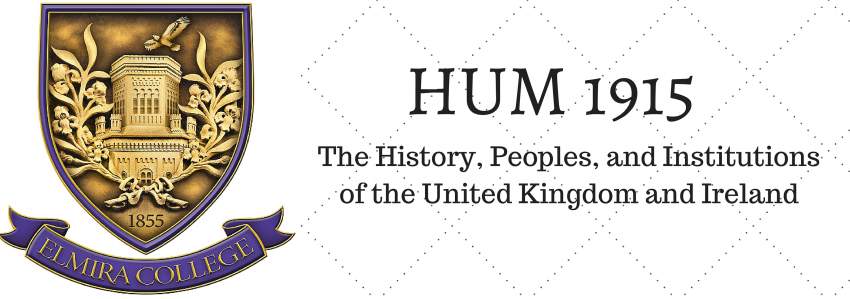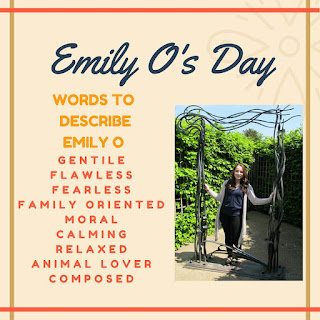- St. Paul's Cathedral
- Bank of England Museum
- The Monument
- Leadenhall Market
- Tower Bridge
- The Queen's Walk
- Shakespeare's Globe Theater
- Tate Modern Art Museum
- Millennium Bridge
The first stop of HUM 1915's whirlwind day was St. Paul's Cathedral. I use the term stop loosely as many of us made the climb up a total of 533 steps to the highest public point on the dome to enjoy the view of the city and look down on the cathedral.
Four structures have previously resided in place of the present Cathedral that was built by Sir Christopher Wren after the previous one was destroyed in The Great Fire of London. It began holding services in 1697 and was the first Cathedral to be built after the 16th century Reformation when Henry VIII gave the monarchy the position of head of the Church of England. Many people are honored in the Cathedral by various monuments. Some of these people include, prison reformer John Howard, Admiral Horatio Nelson, and Arthur Wellesley Duke of Wellington.
No pictures could be taken inside of the cathedral, so here are some pictures of the exterior.
Emily W, Amelia, and Brittany at the first observatory level of St Paul's
The views from the top and a diagram of where we stood at the highest viewing gallery
Four structures have previously resided in place of the present Cathedral that was built by Sir Christopher Wren after the previous one was destroyed in The Great Fire of London. It began holding services in 1697 and was the first Cathedral to be built after the 16th century Reformation when Henry VIII gave the monarchy the position of head of the Church of England. Many people are honored in the Cathedral by various monuments. Some of these people include, prison reformer John Howard, Admiral Horatio Nelson, and Arthur Wellesley Duke of Wellington.
No pictures could be taken inside of the cathedral, so here are some pictures of the exterior.
The group poses in front of St. Paul's
Our next stop was the Bank of England Museum. This was a very interesting endeavor for our class, luckily our accounting and business majors were helpful in understanding the complex concepts that surround finances.
The bank was founded in 1694 and aims to promote good in the United Kingdom by providing the area with financial stability. Stability is achieved by keeping inflation steady and low. The bank was founded on a Royal Charter and was firmly established as a government bank. Bank notes have been used since it's opening in 1694 but are now a much more elaborate concept including colors and calligraphic designs. Queen Elizabeth II was the first monarch to appear on the bank note in 1960.
Emily W and Kaurin
Emily W and Kaurin put together puzzles of bank notes
The bank was founded in 1694 and aims to promote good in the United Kingdom by providing the area with financial stability. Stability is achieved by keeping inflation steady and low. The bank was founded on a Royal Charter and was firmly established as a government bank. Bank notes have been used since it's opening in 1694 but are now a much more elaborate concept including colors and calligraphic designs. Queen Elizabeth II was the first monarch to appear on the bank note in 1960.
The class enjoys the activities part of the museum
The Monument to the Great Fire of London's name basically explains itself. At a glance the monument looks simply, but it is actually very intricate. On the north side are Latin words recording the city's destruction from the fire. On the south is a record of it's restoration. The east is home to the mayoralties during which the building of the monument took place, while the west contains a beautiful sculpture.
The monument was also another great work of the famous Sir Christopher Wren who has built and influenced many others architectural designs in London.
The Monument from a distance
The class stopped to observe the culture of the people of the UK by visiting their local shopping markets and local eateries. Leadenhall Market is a covered market containing some high end stores as well as restaurants, butcher shops, and convenience stores.
On our way around the city the class walked across the Tower Bridge to get a better view of the city and enjoy the view of the Thames River.

The Queen's Walk is a pathway several miles long that guides people to see many of the main attractions in London. These attractions include, the London Eye, the Tower Bridge, St. Paul's Cathedral, Millennium Bridge, Shakespeare's Globe Theater, and Tate Museum.
Our next stop was the famous, Shakespeare's Globe Theater. Built in the 1590's the Globe Theater is located on the south bank of the river Thames in London. The architectural style of the theater is similar to the Colosseum in Rome, having a roof over the audience but open air over the stage. People used to pay a just a penny to stand in the pit to watch performances at the Globe Theater. In 1613 the theater caught fire after a special effects fiasco called the whole building to burn down completely, luckily it was rebuilt in the same spot in 1614. We stayed to watch most of the performance of Taming of the Shrew.
We then continued our journey to Tate Modern Museum of Art where we saw an overwhelming amount of creativity through contemporary pieces.
This piece was a favorite of the class. The sculpture consists of about 800 working radios, of different styles and ages, switched on to different stations with the audible volume, commenting on influx and failure of communication in our modern lives.
Lastly, HUM 1915 took a stroll across the Millennium Bridge. Construction began in 1998 and finally opened in 2000. This is a steel suspension bridge for pedestrians. Formerly known as "the Wobbly Bridge" because the day it opened people began to feel an uneasy swaying movement. Therefore, the bridge was closed again and reopened in 2002.
We then continued our journey to Tate Modern Museum of Art where we saw an overwhelming amount of creativity through contemporary pieces.
Babel 2001 by Cildo Meireles
This piece was a favorite of the class. The sculpture consists of about 800 working radios, of different styles and ages, switched on to different stations with the audible volume, commenting on influx and failure of communication in our modern lives.
Lastly, HUM 1915 took a stroll across the Millennium Bridge. Construction began in 1998 and finally opened in 2000. This is a steel suspension bridge for pedestrians. Formerly known as "the Wobbly Bridge" because the day it opened people began to feel an uneasy swaying movement. Therefore, the bridge was closed again and reopened in 2002.
~~~~~~~~~~~~~~~~~~~~~~~~~~~~~~~~~~~~~~~~~~~



No comments:
Post a Comment